6.06.2021
SpaceX set for late-night launch; engine issue delays ULA's Atlas V

SpaceX is set for yet another Falcon 9 rocket launch over the weekend, this time targeting early Sunday for its mission to boost a SiriusXM satellite to orbit.
If weather cooperates, the 230-foot rocket will launch during a two-hour window that opens at 12:25 a.m. Sunday. Conditions around Cape Canaveral Space Force Station's Launch Complex 40 are expected to be 60% "go," according to a Friday forecast released by the military branch, with potential for showers and storms.
"Showers and storms are expected inland of the spaceport before sunset, with lingering mid- and upper-level convective debris clouds around for the primary launch late-night window," Space Launch Delta 45 forecasters said. "A few Atlantic showers and cumulus clouds in the vicinity cannot be ruled out."
In the event of a 24-hour delay (to early Monday), weather improves to 80% "go."
Packed into the payload fairing is SXM-8, the latest satellite joining SiriusXM's fleet of radio broadcasters. It follows SXM-7, which also flew on a Falcon 9 from the Cape in December but suffered several payload failures after achieving orbit. SiriusXM later said it would file insurance claims on the spacecraft valued at roughly $225 million.
This will mark the 19th launch of the year for the Space Coast and 18th for Falcon 9.
ULA delays this month's Atlas V mission
United Launch Alliance, meanwhile, on Friday said its next flight of an Atlas V rocket from Launch Complex 41 will have to wait just a little longer.
Citing "vehicle readiness," the company said the mission to launch several Space Force payloads on June 23 will shift to an indeterminate window as teams investigate a hardware issue. Further details were not offered.
ULA CEO Tory Bruno later took to Twitter and said the issue was discovered during Atlas V's last launch of a Space Force missile-warning satellite on May 18. After liftoff and first stage separation, the nozzle of the second stage's Aerojet Rocketdyne RL10 engine vibrated – "ringing" in spaceflight terms – and could be seen in the company's live stream.
"Those watching the live feed may have observed some ringing of RL10s's new carbon nozzle extension," Bruno said via Twitter. "While it did its job, boosting RL10's eye-watering performance even a bit higher, we want to make sure we fully understand that behavior before flying this configuration again."
Bruno also said the mission has not been "indefinitely delayed" and a new schedule will likely be determined soon. The rocket, with five strap-on solid rocket boosters, will fly in its most powerful configuration.
ULA is also responsible for launching Boeing's re-do of an uncrewed Starliner capsule test flight to the International Space Station on July 30, but the second stage engine issue is not applicable to that mission because it uses a different configuration.
Launch Sunday, June 6
- Rocket: SpaceX Falcon 9
- Mission: SiriusXM satellite
- Launch Time: 12:25 a.m. ET
- Launch Window: To 2:26 a.m. ET
- Launch Complex: 40 at Cape Canaveral Space Force Station
- Landing: Just Read the Instructions drone ship
- Weather: 60% "go"
Quelle: Florida Today
----
Update: 13.06.2021
.
ULA delays Atlas 5 launch to study unexpected engine vibrations
United Launch Alliance’s next Atlas 5 launch will carry Boeing’s Starliner crew capsule into orbit July 30 on its second unpiloted test fight, officials confirmed Thursday. An Atlas 5 rocket for the U.S. military previously scheduled for June 23 has been postponed as engineers analyze unexpected vibrations of a new upper stage engine nozzle on a mission last month.
The Atlas 5 rocket slated to launch the Starliner test flight uses two-engine Centaur upper stage using a different version of the Aerojet Rocketdyne RL10 engine. A new RL10 engine variant debuted on the most recent Atlas 5 launch May 18.
The Centaur upper stage’s single upgraded RL10C-1-1 engine completed two successful firings on the May 18 mission to deploy the U.S. Space Force’s SBIRS GEO 5 missile warning satellite into orbit.
But engineers are taking extra time to analyze unexpected vibrations of the RL10C-1-1 engine’s new nozzle extension during last month’s launch, according to Tory Bruno, ULA’s president and CEO. On-board video from the launch showed the nozzle vibrating, or “ringing,” soon it ignited about five minutes after liftoff.
“Those watching the live feed may have observed some ringing of RL10s’s new carbon nozzle extension,” Bruno tweeted. “While it did its job, boosting RL10’s eye watering performance even a bit higher, we want to make sure we fully understand that behavior before flying this configuration again.”
The upgraded RL10C-1-1 engine comes with a performance improvement and is easier to build, according to ULA.

The RL10C-1-1 engine has a larger nozzle than the engines flown on previous Atlas 5 rockets, and introduces a new 3D-printed injector, which is flying on its first operational mission, said Gary Wentz, vice president of government and commercial programs at ULA, during a press briefing before the SBIRS GEO 5 launch last month.
According to Aerojet Rocketdyne’s website, the RL10C-1-1 engine produces about 1,000 pounds of additional thrust over the RL10C-1 engine version used on previous Atlas 5 rockets.
More than 500 RL10 engines have flown on rockets since the 1960s. ULA’s Vulcan Centaur rocket will also use the RL10C-1-1 engine variant, as will all future Atlas 5s except missions with Boeing’s Starliner crew capsule, which uses a unique dual-engine Centaur upper stage.
The twin-engine Centaur is powered by RL10A-4-2 engines, an older variant of the RL10 without the carbon nozzle extension.
The U.S. military’s Space Test Program-3, or STP-3, mission was next on ULA’s launch schedule. The STP-3 mission was scheduled for launch June 23 with multiple military spacecraft heading into a geosynchronous orbit more than 22,000 miles (nearly 36,000 kilometers) over the equator.
One of the satellites on the STP-3 mission, named STPSat 6, hosts several payloads and experiments, including the National Nuclear Security Administration’s Space and Atmospheric Burst Reporting System-3 payload, which is designed to detect nuclear detonations from orbit. NASA’s Laser Communications Relay Demonstration experiment and several more payloads are also flying on the STPSat 6 spacecraft.
A smaller satellite named LPDE 1 will ride into orbit with STPSat 6. The LPDE 1 spacecraft is designed to accommodate experimental payloads and small satellites, which could be deployed from the parent satellite in orbit.
The STP-3 mission will launch on an Atlas 5 rocket flying in the “551” configuration with five strap-on boosters, a 5.4-meter (17.7-foot) diameter payload fairing, and a single RL10C-1-1 engine on the Centaur upper stage.

ULA last week announced the delay in the STP-3 mission to analyze the engine nozzle vibrations. The company, a 50-50 joint venture between Boeing and Lockheed Martin, confirmed Thursday that the Starliner test flight, using the older RL10 engine variant, will launch ahead of the STP-3 mission.
The Starliner’s second unpiloted test flight is a redo of a demonstration mission in December 2019 that failed to reach the International Space Station. Boeing and NASA officials blamed the botched test flight on software issues, and the reusable capsule safely landed in New Mexico after mission control aborted the mission to the space station.
Developed with more than $5 billion in NASA funding, Boeing’s Starliner spacecraft is designed to ferry astronauts to and from the space station. NASA has a contract with Boeing for at least six Starliner crew rotation flights to the space station, giving the agency a second U.S. vehicle for astronaut missions to low Earth orbit, following the start of operational service with SpaceX’s Crew Dragon capsule last year.
The Starliner mission set for launch July 30, known as Orbital Flight Test-2, is a prerequisite to the Boeing crew capsule’s first test flight with astronauts. The OFT-2 mission is expected to last between four and eight days, according to Joel Montalbano, NASA’s program manager for the International Space Station.
Three astronauts will dock with the space station on the Starliner’s Crew Flight Test.
After the Crew Flight Test, NASA will certify the Starliner to fly on operational crew rotation missions to the space station. Those flights will carry four astronauts and last up to seven months.
Quelle:SN
----
Update: 21.11.2021
.
NASA Invites Public to Share Launch of Laser Communications Demonstration

NASA is inviting the public to take part in virtual activities and events ahead of the launch of the agency’s Laser Communications Relay Demonstration (LCRD) mission. Launch is scheduled for 4:04 – 6:04 a.m. EST on Saturday, Dec. 4, 2021, aboard a United Launch Alliance Atlas V 551 rocket from Space Launch Complex 41 at Cape Canaveral Space Force Station, Florida.
LCRD will showcase the unique capabilities of optical communications to increase bandwidth for communicating in space while reducing size, weight, and power requirements. LCRD will fly as a payload on Space Test Program Satellite-6 (STPSat-6), the primary spacecraft of the Space Test Program 3 (STP-3) mission for the Department of Defense.
Members of the public can register to attend the launch virtually. NASA’s virtual guest program for this launch includes curated launch resources, behind-the-scenes looks at the mission, and a virtual guest passport stamp following a successful launch.
Live coverage and countdown commentary of the launch will begin approximately 35 minutes before launch and air on NASA Television and the agency’s website, as well as YouTube, Twitter, Facebook, LinkedIn, Twitch, Daily Motion, Theta.TV and the NASA App.
The Laser Communications Relay Demonstration (LCRD) will be NASA’s first end-to-end laser relay system, sending and receiving data over invisible infrared lasers at a rate of approximately 1.2 gigabits per second from geosynchronous orbit to Earth. With data rates 10 to 100 times higher than traditional radio frequency systems, laser communications systems will provide future missions with extraordinary data capabilities.
Engineers will beam data between LCRD and optical ground stations located in Table Mountain, California, and Haleakalā, Hawaii, once it is positioned more than 22,000 miles above Earth. Experiments will refine the transmission process, study different operational scenarios, and perfect tracking systems. The information and data are essential for readying a laser communications system for an operational mission because engineers cannot replicate the same conditions with ground tests.
Members of the public can also share in the journey through a variety of activities, including:
Virtual Launch Passport
Print, fold, and get ready to fill your virtual passport. Stamps will be emailed following launches to those who register.
STEM Toolkit
Teachers and students can explore the LCRD STEM Tool Kit. The kit includes five activity sheets, each designed for a target grade level range, a model of STPSat-6 that students and teachers can 3D print, an overview of LCRD, and several other printables. Many of the toolkit resources are also available in Spanish.
Watch and Engage on Social Media
Stay connected with the mission on social media and let people know you're following it on Twitter, Facebook, and Instagram. Follow and tag these accounts:
- Twitter: @NASA, @NASAGoddard, @NASALaserComm, @NASA_Technology, @NASASCaN
- Facebook: NASA, NASAGoddard, NASA Technology, NASA Space Communications and Navigation
- Instagram: NASA, NASAGoddard
LCRD is led by NASA’s Goddard Space Flight Center in Greenbelt, Maryland. Partners include NASA’s Jet Propulsion Laboratory in Southern California and the MIT Lincoln Laboratory. LCRD is funded through the Technology Demonstration Missions program in NASA’s Space Technology Mission Directorate and the Space Communications and Navigation program at NASA Headquarters.
Quelle: NASA
----
Update: 3.12.2021
.
Space Force plans to launch experimental satellites early Sunday
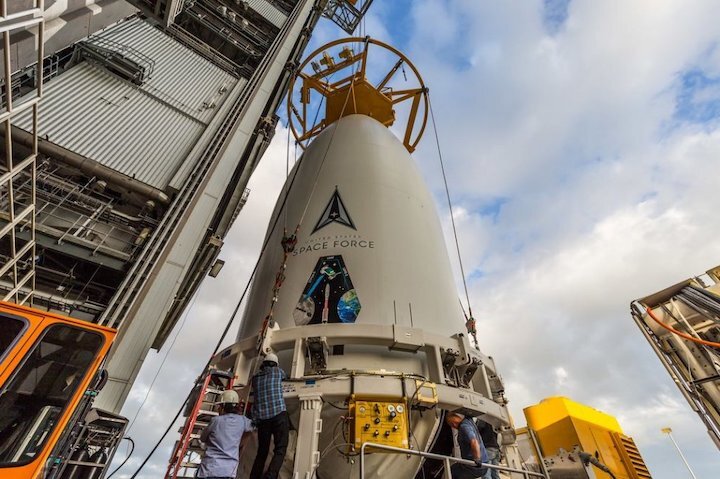
ORLANDO, Fla., Dec. 3 (UPI) -- The U.S. Space Force plans to launch a cluster of experimental satellites known as STP-3, including a NASA laser communications spacecraft, into orbit Sunday morning from Florida.
United Launch Alliance has scheduled liftoff of the Atlas V rocket during a two-hour window starting at 4:04 a.m. EST from Complex 41 at Cape Canaveral Space Force Station.
The mission was delayed for various reasons from this summer, Col. Carlos Quinones, director of the Space Force's Space Test Program, said in a press conference Thursday.
"We've been working on this for a very long time, so we're very excited about that," Quinones said.
The $1.14 billion mission will carry a number of classified spacecraft to aid navigation and communication in space, including a satellite to aid detection of nuclear detonations in space, Quinones said.
The suite of satellites is bound for a very high orbit -- more than 22,000 miles above the Earth -- said Gary Wentz, ULA vice president of government and commercial programs.
Therefore, the rocket will be augmented by five boosters, he said.
"The [rocket] is the most powerful Atlas in our fleet," Wentz said. The altitude of the mission means the STP-3 "will become the longest mission with seven hours and 10 minutes until separation ... and 8 hours, 8 minutes until the end of the mission," he said.
NASA spent about $320 million on its contribution to the mission, the Laser Communications Relay Demonstration spacecraft.
LCRD will demonstrate how huge amounts of data may be beamed to Earth from high orbits in space, including lengthy high-definition videos, within seconds using optical laser light beams, David Israel, NASA's exploration and space communications division architect, said in an interview.
Such laser communications would eclipse radio in terms of the time and amount of data that could be sent from space, he said.
"We're really trying to figure out the best way to send large amounts of data from the moon or Mars," he said. "We've done brief experiments before, but the LCRD mission will help us understand how lasers work, or don't, through the clouds and atmosphere."
Quelle: UPI
----
Update: 4.12.2021
.
NASA’s Next Laser Communications Mission
Powerful ULA Atlas V rocket rolls to pad ahead of Space Force launch this weekend
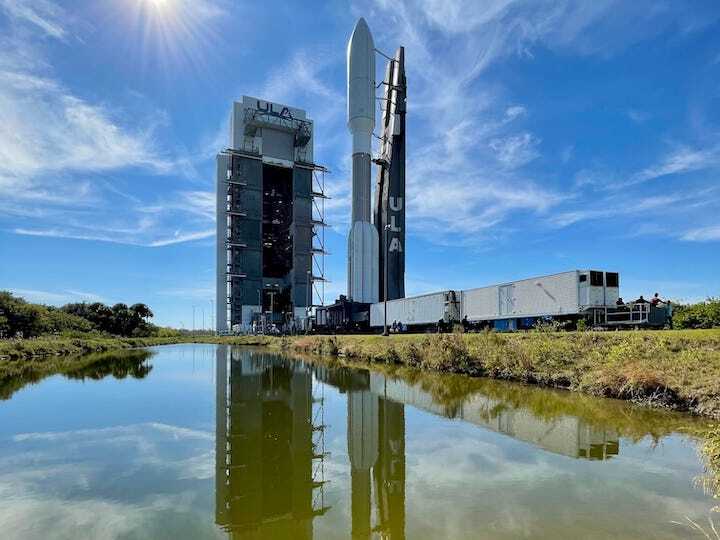
A nearly 200-foot Atlas V rocket rolled to its pad at Cape Canaveral Space Force Station Friday afternoon, putting the most powerful configuration of the vehicle on course for launch this weekend.
Five add-on solid rocket boosters gleamed in the afternoon sunlight as United Launch Alliance teams guided the rocket over its third-of-a-mile trek from Launch Complex 41's Vertical Integration Facility to the pad. At liftoff, currently set for a two-hour window that opens at 4:04 a.m. Sunday, Atlas V's RD-180 main engine and five SRBs will produce nearly 2.4 million pounds of thrust to vault off the pad.
Space Force weather forecasters on Friday said conditions for liftoff should be excellent at 90% "go." The less-than-likely possibility of cumulus clouds forming around LC-41 was noted as the only concern.
Temperatures at the time of liftoff, meanwhile, should be a bit warmer than other mornings this week: 65 to 67 degrees.
Packed into Atlas V's payload fairing will be the Space Force's Space Test Program-3 mission, or STP-3, which features payloads from several organizations. The main payload, STPSat-6, is essentially operating as the platform to carry the following hardware:
- The National Nuclear Security Administration's Space and Atmospheric Burst Reporting System-3, or SBARS-3. The roughly one-foot-wide payload developed by the Los Alamos National Laboratory will help with the detection of nuclear detonations.
- NASA's Laser Communications Relay Demonstration (LCRD) experiment, which will test the ability to transmit data via lasers. Laser-based communications systems are able to handle more data than traditional radio-based options.
- Several additional payloads owned by the Department of Defense will also provide insights into space weather, such as solar flares, and situational awareness, according to ULA.
Compared to more "routine" launches, Sunday's STP-3 mission is already unique thanks to the variety of payloads. But how they get to geosynchronous orbit some 22,200 miles above the equator – and how long it takes to get there – will also be quite different.
"This is a highly complex orbital insertion that requires three Centaur (upper stage) burns and precise navigation, a capability unique to the Atlas V," Gary Wentz, ULA's vice president of government and commercial programs, said in a Thursday statement. "This is our longest mission to date at seven hours and 10 minutes until final spacecraft separation."
Spectators heading outside to watch Atlas V should note the trajectory for Sunday's mission is a bit different – after liftoff, the rocket will fly straight out toward the east rather than what's usually a northeastern trajectory. The crisp, cool morning air should make for above average visibility, too.
Launch Sunday, Dec. 5
- Rocket: United Launch Alliance Atlas V
- Configuration: 541 (5-meter fairing, 5 solid rocket boosters, 1 upper stage engine)
- Mission: Space Force's STP-3
- Launch Time: 4:04 a.m. ET
- Launch Window: To 6:04 a.m. ET
- Launch Complex: 41 at Cape Canaveral Space Force Station
- Trajectory: East
- Weather: 90% "go"
Space Test Program 3 Launch Update, Now Targeted for Dec. 7
The Dec. 6 launch of a United Launch Alliance (ULA) Atlas V 551 rocket carrying the Department of Defense’s (DOD) Space Test Program 3 (STP-3) mission has been scrubbed. The team repaired the ground storage system but will require additional time to verify the sample integrity of the fuel prior to tanking operations. Launch of the mission – which hosts NASA’s Laser Communications Relay Demonstration(LCRD) and the NASA-U.S. Naval Research Laboratory Ultraviolet Spectro-Coronagraph (UVSC) Pathfinder – is now scheduled for Tuesday, Dec. 7, at 4:04 a.m. EST.
NASA TV live launch coverage will start approximately 35 minutes before launch on Dec. 7, at 3:30 a.m. EST.
Quelle: NASA
----
Update: 7.12.2021
.
Dec. 7, 2021 as ULA's Atlas V rocket lifts off from Cape Canaveral Space Force Station with the Space Test Program (STP)-3 mission for the U.S. Space Force's Space Systems Command (SSC). Launch is scheduled for 4:04 a.m. EST (0904 UTC). Broadcast is scheduled for 3:30 a.m. EST.

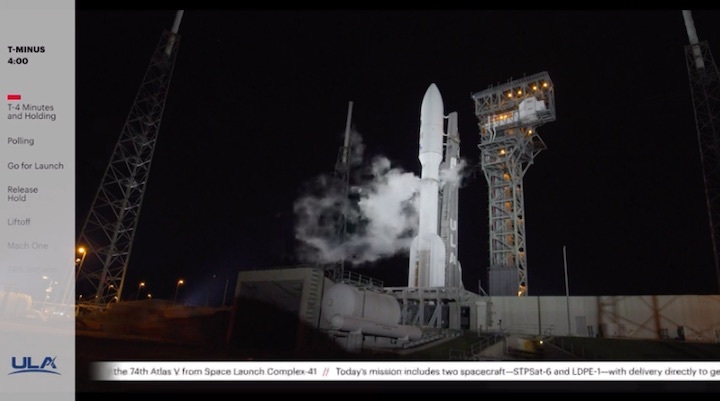
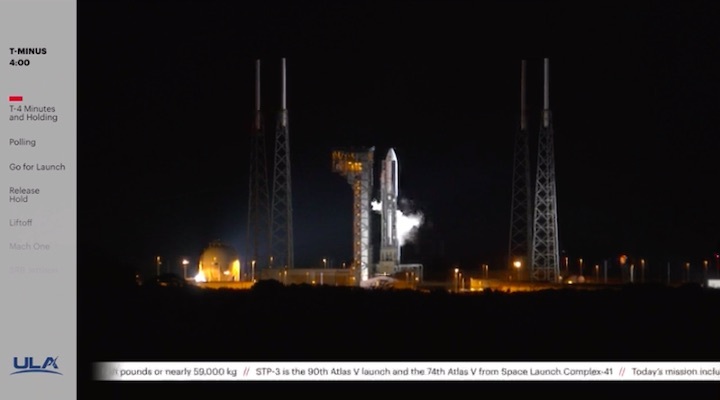





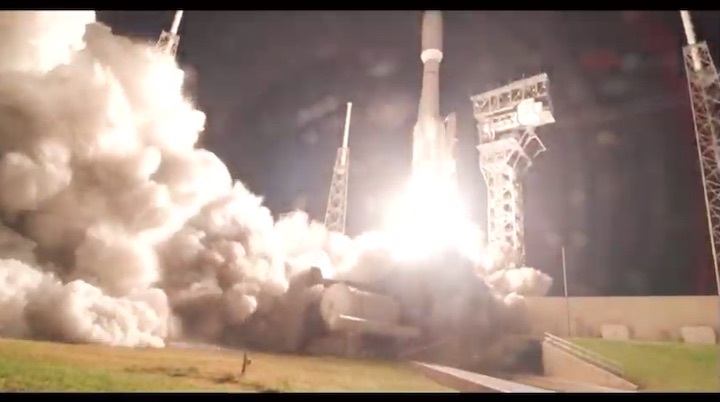
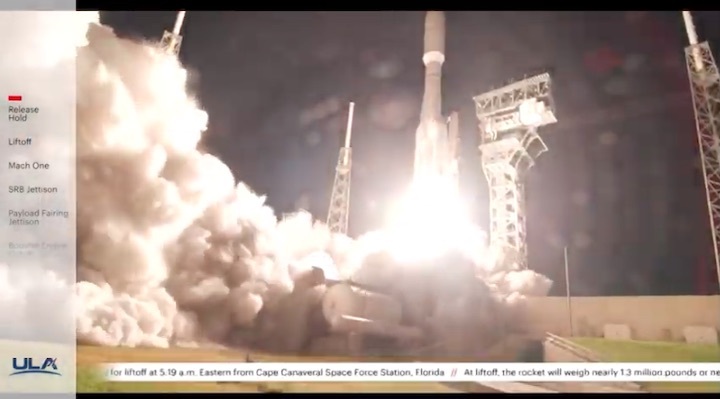




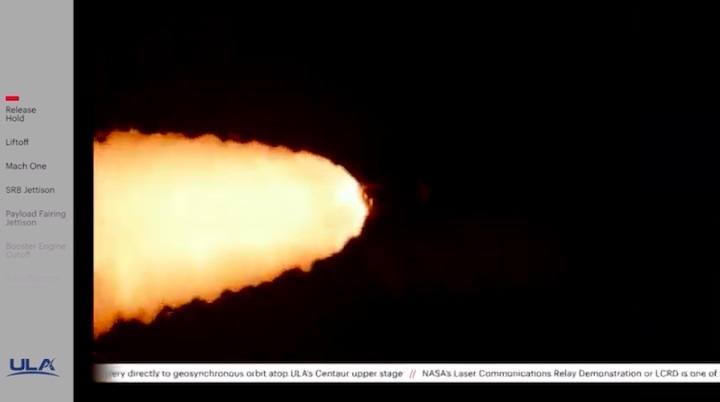










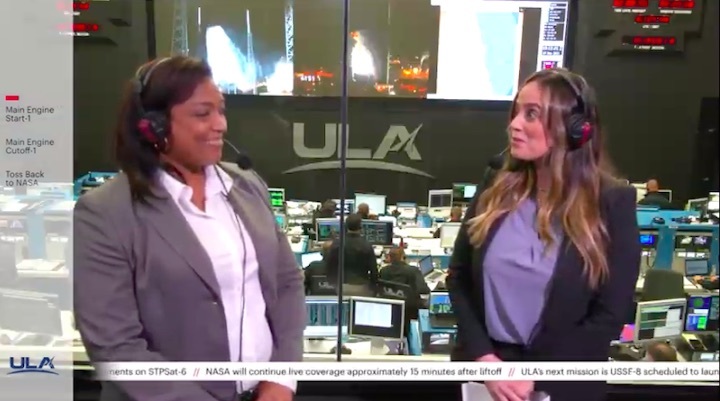



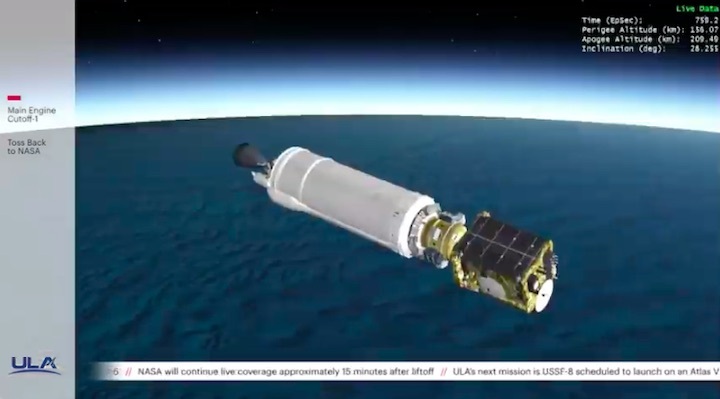



Quelle: ULA

